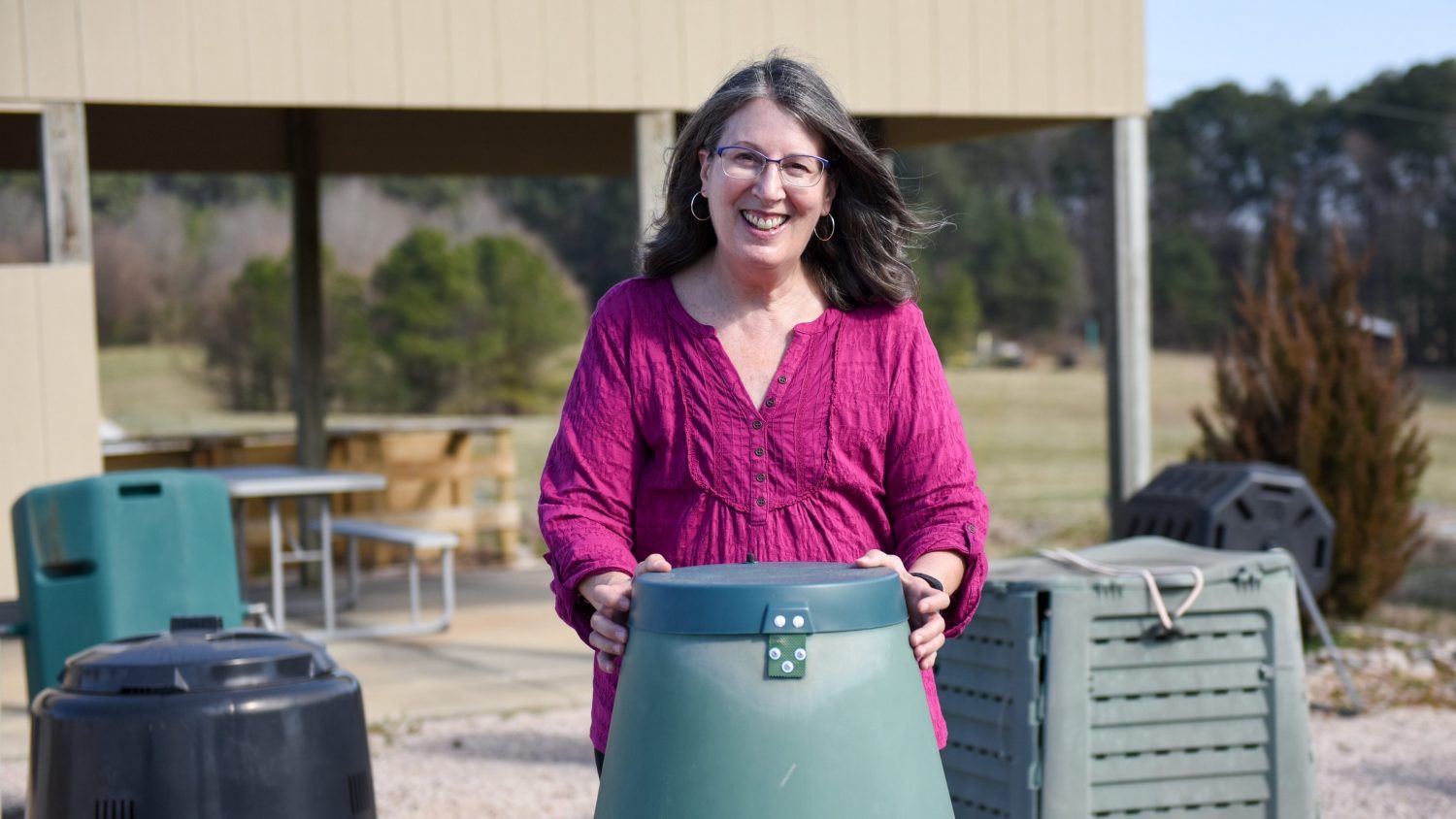Writing the Book on Vermicomposting

Written by Juliana McCully
A culture for healthy eating means there’s a big appetite for a new book about worm-farming by Rhonda Sherman, NC State Extension specialist in the university’s Department of Horticultural Science and a leading authority on vermicomposting.
“The Worm Farmer’s Handbook: Mid- to Large-Scale Vermicomposting for Farms, Businesses, Municipalities and Institutions” (Chelsea Green Publishing) encompasses 25 years’ experience working with commercial worm-growers and researchers around the world, and it has been called “the first and only authoritative how-to guide that goes beyond small-scale operations and demystifies the science and logistics of the fascinating process that is vermicomposting.”
A Sustainable Waste Management Solution
[pullquote align=right color=red]Vermicomposting manure and crop waste on farms improves yields and reduces demand for off-farm inputs, like fertilizer.[/pullquote]
From livestock farms and restaurants to military bases, schools, municipalities, prisons, and community gardens, the book shows how and why commercial-scale vermicomposting is a fast-growing, sustainable solution for organic waste management – to process food residuals and other materials, for example.
The end-product, vermicast, is a biologically active, nutrient-rich mix of earthworm castings and decomposed organic matter. It sells for $200 to $1,800 per cubic yard and outperforms regular compost, which is sold for about $30 per cubic yard.
Vermicomposting manure and crop waste on farms improves crop yields while reducing demand for off-farm inputs. Vermicast has higher nutrient levels and lower soluble salt content than regular compost, and it improves soil aeration, porosity and water retention. Vermicast also suppresses plant diseases and insect attacks.
Details, Details
The book digs into all the details, including choosing the right production system; regulatory issues; developing a business and marketing plan; finding and managing feedstocks; pre-composting; monitoring an active worm bed; harvesting, screening, testing, packaging and storing vermicast. The book also covers how vermicast benefits soils and plants; markets for earthworms and vermicast; food security; and avoiding common pitfalls.
[pullquote color=”red” align=”left”]It’s essential to have a business and marketing plan.[/pullquote]“I just wanted people to know a variety of things they should be considering when they go into vermicomposting,” Sherman said. “I noticed that many are very focused on equipment and try to launch a large vermicomposting operation with no earthworm husbandry skills. They buy 50 pounds of worms (that’s 50,000 worms!) with no experience raising earthworms.
“What are you going to do with them? What are you going to feed them? How are you going to shelter them? How are you going to protect them from the elements?”
It’s also essential to have a business and marketing plan, she said, even though it may seem “boring” – people want to “skip to the good part, where we learn about the worms.”
“I visited this 70-acre farm in Texas, where they had set aside seven acres for vermicomposting. They had a great system set up with conveyor belts for harvesting and bagging their vermicast. They had hundreds, if not thousands, of bags reaching the ceiling of their barn. It was a nicely laid out operation, but they never sold a single bag because they hadn’t developed a marketing plan.”
Safety First
Sherman also addresses safety in depth, “because some people don’t think about safety, and that needs to be part of your business plan: You want to make sure you don’t burn down your operation or get anyone harmed or sick. There are all kinds of ways to mess it up.”
[pullquote align=”right” color=”red”]Pathogens exist all over the place, and you have to be constantly aware of that.[/pullquote]“Too many people are just really casual – they’re like, ‘Oh, it’s organic; it’s safe.’ But pathogens exist all over the place, and you have to be constantly aware of that and do what you can to protect people, plants and pets from pathogens.”
She also hopes the book clarifies terms, especially understanding the difference between composting and vermicomposting. “It’s really important to differentiate between composting and vermicomposting — they’re two different processes,” Sherman said. “and their products have substantial differences.”
She is also excited about the possibilities for women: “I’ve always been very drawn to the fact that, in many parts of the world, women are finding financial independence through vermicomposting. That’s happening a lot in India, for example, where if you’ve lost your husband, you’re basically out of luck and have no means of income. But through vermicomposting, if somebody gives you some worms, then you can use cow dung and food scraps, and you can create this valuable soil amendment.”
Think It Through
Sherman shares compelling stories of a couple billionaires and some large-scale producers, but a big goal for the book is encouraging would-be worm-farmers, especially mid-scale operations: “I like to give examples so that people can see a wide spectrum of ways to do it,” she said. “So, if all you have is an old bathtub or concrete blocks, you can use that to produce vermicompost.”
Bottom line: “Think it through and do as much research as possible. Don’t trust much of what you read on the internet,” she said. “I always encourage my audiences to look for things that end in edu or gov, and I make it clear in my book that this is unbiased information. I have nothing to sell here — all I want is for people to be successful at whatever their endeavor is.”
Our faculty Think and Do the Extraordinary every day.
[button]Watch Our Vermicomposting Video.[/button]
[button]Support CALS faculty[/button]
- Categories:


